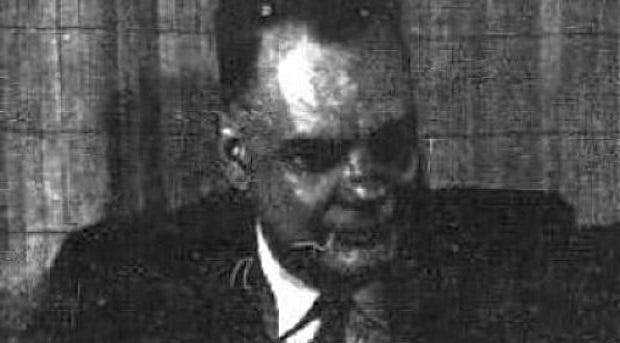Whenever you hear of Weird Tales, a select few authors come to mind: H.P. Lovecraft, Robert E. Howard, Clark Ashton Smith, Robert Bloch, and others. It was within the pages of the “Unique Magazine” that Conan the Barbarian and the great god Cthulhu first made their debuts. Other standouts, from Seabury Quinn’s occult detective Jules de Grandin to Paul Ernst’s supervillain Doctor Satan, similarly made the magazine legendary.
Knowing this, it may surprise you that readers of Weird Tales listed an obscure 1939 short story as the best piece of fiction every published by the magazine. “Far Below” is a kind of two-fisted version of Lovecraft’s “Pickman’s Model,” where a secret branch of the New York Police Department uses Tommy guns to do nightly battle with an army of ghouls infesting the city’s subway tunnels. The story’s author, Robert Barbour Johnson (1907-1987) earned his footnote in history with “Far Below,” but Johnson was more than a one-hit-wonder. For several decades, Johnson quietly churned out excellent horror stories and Fortean essays, some of which deserved to be remembered as classics within the genre.
Johnson grew up a Weird Tales fan as a youth in the small town of Hopkinsville, Kentucky. As a young man, Johnson took up the pen as both a journalist for the New Orleans Item and as a pulp writer who plied his trade in the crime and detective magazines of the day. At the same time, Johnson ran off with the circus…literally. The 1920s saw Johnson as a press agent for a traveling circus. Johnson sometimes hit the road with carnies, and he picked up a few tricks along the way. Most notably, Johnson learned how to train house cats.
The Great Depression ended Johnson’s run with the circus, and not content to spend his winters in New York City, he relocated to San Francisco in 1930. According to weird fiction writer and editor Jeff Vandermeer, Johnson found his milieu in Fogtown. The self-proclaimed outsider and lifelong bachelor joined a Fortean society in the city, and made friends with an odd assortment of artists and oddballs, including Clark Ashton Smith, cryptozoologist George F. Haas, and Anton LaVey, the founder of the Church of Satan. Most of Johnson’s weird horror tales were written around this time, and one of them— “Lead Soldiers” (Weird Tales, December 1935)—earned the author a letter of appreciation from Lovecraft himself.
Besides “Far Below,” Johnson’s most frequently anthologized tale appeared in the January 1939 edition of Weird Tales. “The Silver Coffin” is a short, sharp, and gothic vampire yarn set amidst the bygone world of old Virginia. Here, a wizened caretaker explains his special job for the decayed Holt family and their ancestors…their undead ancestors. “The Silver Coffin” still occasionally appears in cheap collections of vampire stories, and I for one first stumbled upon the tale after purchasing a bargain-rate paperback from Barnes & Noble over two decades ago.
For most readers, “Far Below” and “The Silver Coffin” are as far as they go with Johnson. You cannot blame them; Johnson’s oeuvre is fairly limited. Although he kept writing well into the 1960s, his output remained limited, with occasional horror stories for small magazines like Mystic and Magazine of Horror intermixing with carnival sketches for Blue Book and essays for various Fortean publications. Johnson supplemented his meager income by selling circus paintings, including those that were displayed at the Golden Gate International Exposition. During the Second World War, Johnson followed in the footsteps of other Weird Tales writers like Donald Wandrei and Joseph Payne Brennan by donning a uniform. Johnson served with 1952th Service Command Unit. After the war, he returned to San Francisco where he continued to paint, write, and wander.
All self-respecting lovers of weird fiction owe it to themselves to read Johnson’s two best-known stories. Also worth everyone’s time are some of Johnson’s later tales, like 1964’s “The Life-After-Death of Mr. Thaddeus Warde” and “The Pet of Mrs. Lilith,” which appeared alongside other Weird Tales veterans in the 1967/1968 issue of Startling Mystery Stories. Both are tremendous chillers that are reminiscent of the halcyon days of Farnsworth Wright and Virgil Finlay.
Johnson may have not been as innovative as Lovecraft, Howard, or Smith, but his stories, though often quaint, tend to invoke great atmosphere and show a special genius for the gothic. Johnson’s oeuvre proves the correctness of quality over quantity, and his handful of startling, weird, and shocking horror stories deserve a new appreciation from today Neo-Pulpsters and horror enthusiasts.



I love Far Below! I wasn't as into the others in this collection, but maybe I should give them another try.
Thank you for this informative article which, at least for me, served a double purpose: it provided interesting biographical details and reminded me to read the anthology Far Below edited by Robert E. Weinberg and of course opened by Johnson himself. There he is beside Seabury Quinn and Howard and Earl Pierte Jr. or Mindret Lord. Known and Unknown. Long live the pulps!